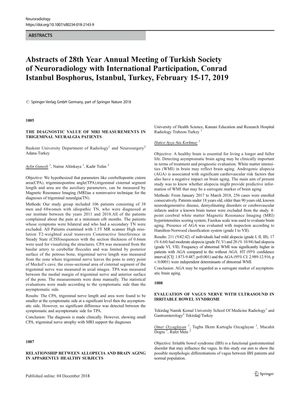Abstracts of 28th Annual Meeting of Turkish Society of Neuroradiology with International Participation, Conrad Istanbul Bosphorus, Istanbul, Turkey, February 15-17, 2019
December 2018
in “
Neuroradiology
”

TLDR MRI helps distinguish between pituitary adenomas and craniopharyngiomas, guides treatment for pediatric CNS tumors, and assesses rhinocerebral mucormycosis with a high mortality rate in transplanted patients.
A retrospective analysis of MRI findings in 45 pituitary adenomas and 41 craniopharyngiomas identified specific shapes and contrast enhancement patterns that help distinguish between the two types of tumors. Craniopharyngiomas were more likely to have a superiorly lobulated shape, compress the third ventricle, and show reticular enhancement, while adenomas typically presented with a snowman shape, solid content, and homogenous enhancement. In another study, perfusion MRI proved useful in making clinical decisions for 26 pediatric patients with malignant CNS tumors, influencing treatment choices such as chemotherapy, surgery, or radiotherapy. Additionally, MRI evaluations of 5 pediatric patients with rhinocerebral mucormycosis after hematopoietic stem-cell transplantation indicated all patients had hypointense signals on T1 and T2 weighted images without contrast enhancement and diffusion restriction, with a high mortality rate of 60%. These studies highlight the critical role of MRI in diagnosing and managing these medical conditions.